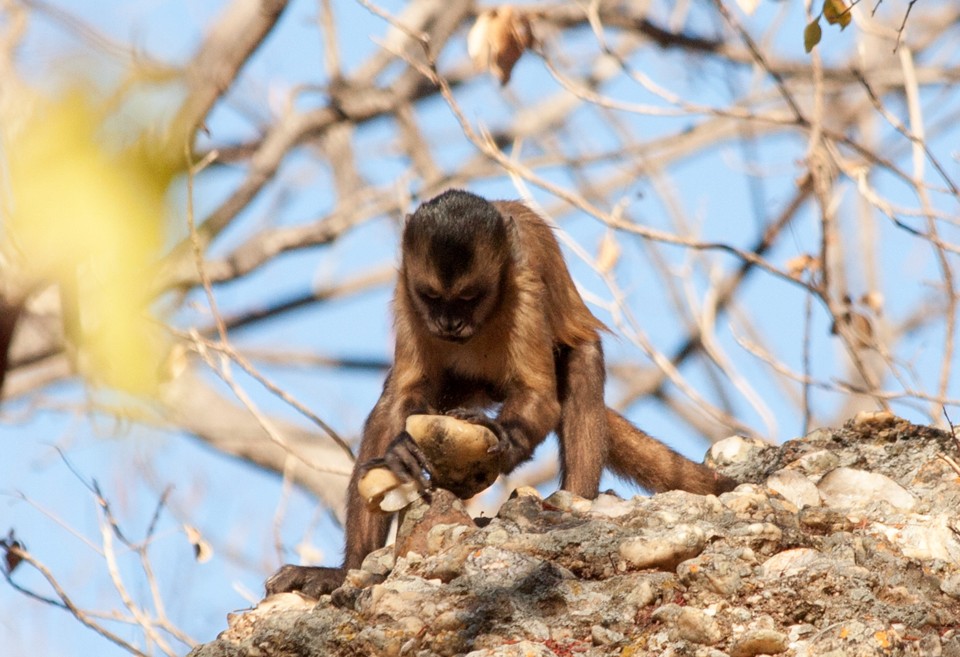The Ed's Up #158

Rock-Smashing Monkeys Unintentionally Make Sharp Stone Tools
"In 2014, Michael Haslam wedged between two boulders in northeast Brazil and filmed some monkeys smashing stones together. They lifted small cobbles into the air and brought these down upon a rock face, like a hammer upon an anvil. In the process, the hammer stones would often shatter. After the monkeys had gone, Haslam picked up some of these broken fragments—and was amazed. Many had sharp edges, and looked remarkably like human tools. For millions of years, humans and our ancestors have been using one stone to hammer flakes away from another, leaving behind smoothly curving surfaces with sharp edges or tips. Haslam knew such tools well. “And here were monkey by-products, which I’d seen being made, that had all the hallmarks of basic flaked tools,” he says." (Image: T. Falotico)

Arizona’s Adorable Monster
"No one has ever died from a Gila monster bite because the toxins aren’t great at destroying cells and tissues. They do, however, hurt like a sonofabitch. “It felt like my finger was caught in the door of a car,” says DeNardo of his one and only bite, “and then like being hit by a hammer every ten seconds. For 45 minutes, I couldn’t concentrate.” That was a hatchling too, and one that lightly nipped him. Adults have a reputation for hanging on with bulldog tenacity, chewing as they bite to release more venom. If that happens, “find a tree, sit in the shade, and suffer,” DeNardo advises. “Don’t drive yourself to a hospital. You won’t die from the bite, but you’ll die from an accident.”" (Image: Will Burgess)

What a Legless Mouse Tells Us About Snake Evolution
"At a lab in Berkeley, California, there’s a mouse with no legs. Its head, torso, and tail are normal. It just lacks limbs. It didn’t lose those limbs; it just never grew them originally. And that’s because a team of researchers led by Axel Visel at the Lawrence Berkeley National Laboratory had replaced part of its DNA—a small sequence known as ZRS—the equivalent sequence from a snake. That tiny change was enough to “serpentize” the mouse, to stop it from developing any limbs." (Image: Erik de Castro) 
Sperm Whales Bring New Lingo to New Neighborhoods
"The whales had disappeared, and now they were back. Or were they? Since 1985, Hal Whitehead had been leading a team to the Galápagos Islands to search for sperm whales, which gather there in the thousands. The researchers tracked the animals with underwater microphones, day and night, for two to four weeks. Their recordings revealed that the whales belonged to two distinct vocal clans—large groups that each call using their own dialect. The Regularclan makes a train of regularly spaced clicks, while the Plus-One clan leaves a short pause before their last click. The two clans share both genes and oceans—they are distinct only in their vocal culture." (Image: Flip Nicklin)
More good reads
- In this stunning essay, Robinson Meyer explores the link between climate change, conflict, and fascism. And here’s Rob again with another great piece on a terrifying thing glacier can do: become mile-long avalanches travelling at 150mph.
- An important corrective to Outside’s inaccurate, hyperbolic obituary of the Great Barrier Reef. By Chris D’Angelo
- Behold: the bizarre monkey slug
- An astonishing example of camouflage
- The ‘Higgs bison’ mystery is solved with the help of ancient cave paintings. By Sarah Kaplan.
- 3-D printing and a low-tech way of colonizing Mars. By Sarah Zhang.
- The winners of the Wildlife Photographer of the Year awards are always stunning. But spare some time too for the winners of the Comedy Wildlife Photography Awards
- Too much brain: an emphasis on neuroscience prevents the funding of research into therapies that could be deployed much faster. By John Markowitz
- NASA raised thousands of jellyfish in space. They ended up unfit for life on Earth. By Megan Garber, headline queen.
- The ‘Swiss Agent’: Long-forgotten research unearths new mystery about Lyme disease. By Charles Piller
- On palaeontology
- Wild chimpanzee mothers teach young to use tools. By Gerry Everding
- Facial expressions might not be as universal as they’re meant to be. By Michael Price
- And finally, CRISPR has really hit the mainstream!
And that's it! Thanks for reading.
And that's it! Thanks for reading.